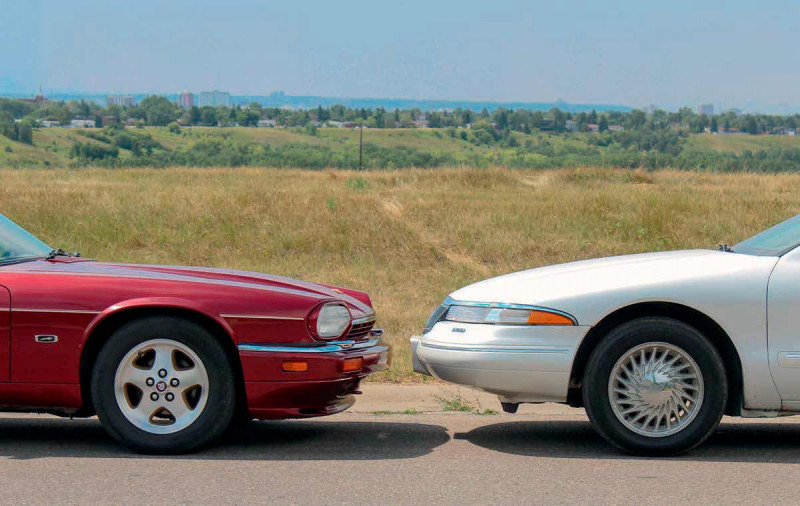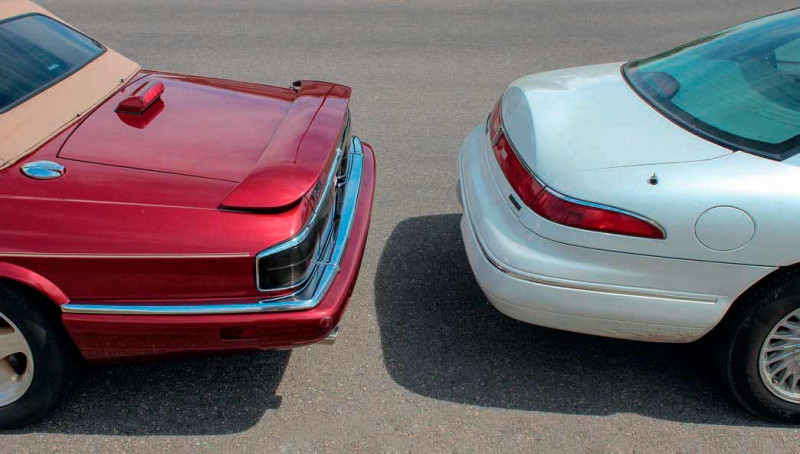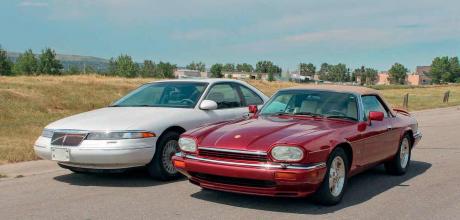1994 Lincoln Mark VIII vs. 1993 Jaguar XJS Convertible 6.0 V12
In the mid ‘90s, would a Canadian buyer spend the cost of a small house on an XJS coupe, or go for a cheaper home market alternative? Craig Talbot investigates the choice. Words: Craig Talbot. Photography: Ray Ingman.
TWIN TEST XJS vs LINCOLN COUPES IN NORTH AMERICA
RIVALS IN AMERICA US XJS VERSUS LINCOLN
Our new North American correspondent, Craig Talbot, compares rival coupes on his home soil
Today the hottest segment of the automotive market is the SUV, or Sports/Utility vehicle. In the 1970s cars represented by another 3-letter acronym were the hot sellers: the PLC or Personal Luxury Coupes. By the 1990s the PLC market had shrunk to a shadow of its former self, as the rise of the minivan and SUV stole sales from the PLC. However, two companies firmly ignored both those markets in the early ‘90s and here we'll look at two choices which upmarket Canadian buyers had for PLCs in 1994: The Lincoln Mark VIII and the Jaguar XJS V12.

The Lincoln Mark series had a long history as the flagship line of Ford's Lincoln division, beginning in 1956 and followed by the Mark III, IV and V in the 1970s, all as 2-door coupes with the distinctive spare tire hump on the trunk lid. Most had the 460 CID (7.5L) V8 engine, with the final Mark V's having a 400 CID (6.6L) V8 engine. The 1980s brought radical changes to the Mark VI, as it was offered in either 2-door coupé or 4-door sedan. It shed both weight and bulk by now being built on the «Panther» platform, instead of the Thunderbird platform. The 1980 Mark VI lost 14 inches in length and 800 lbs compared to the Mark V. Engines were much smaller as well, with the 129 hp 302 CID V8 being the only option, but performance was actually better due to the lower weight. The Mark VI was notable for being the first car to have keyless entry; a code could be entered into a keypad to unlock the doors or trunk.
“On the road the Lincoln feels much nimbler than the XJS, partly due to its being nearly 600lbs lighter...”

As much as the Mark VI changed compared to the Mark V, the Mark VII introduced in 1984 was a radical change from the Mark VI. It was further downsized, now being based on the Mustang «Fox» platform, and it shared the Mustang «high output» 302 engine, now called the 5.0L, ranging from 150 to 215 hp depending on year. It was also the first car in North America to have 4-channel l ABS brakes, in addition to having 4-wheel disc brakes and air suspension. It moved the Mark series well away from the large highway cruisers that the 1970s Marks had been, toward being the “Hotrod Lincoln” of the ‘80s.
Its successor, the subject car here, was the final Mark series, the Mark VIII, introduced for the 1993 model year. It took the sporty theme and developed it further from the Mark VII. The Mark VIII had both a new platform (the MN12), and a new engine and transmission. In a nod to history, the MN12 was shared between the Mark and the now downsized Ford Thunderbird/Mercury Cougar. The Mark VIII had many different features compared to the Thunderbird, such as alloy suspension components instead of steel, and a more refined air suspension.
Unique to the Mark VIII, the 4.6L 32 valve DOHC V8 InTech engine was part of Ford's Modular family and was an all-alloy engine, unlike the SOHC 4.6 used in the sister Lincoln Town Car. In standard trim the InTech 4.6 developed 280 hp, and the LSC trim added dual exhaust for an extra 10 hp. Also introduced with the Mark VIII was the new 4R70W 4-speed electronic automatic transmission.
BRITISH RIVAL
The XJS, introduced in 1975, was nearing the end of its production run in 1994, but was still being updated. It was introduced with a facelift for the 1993 model year incorporating new bumpers and lights giving the car a more modern appearance. For the Canadian and US markets the V12 cars came equipped with a trunk-mounted spoiler and a third brake light. For 1994 the brake light was separate and mounted on the trunk lid; in 1995 the brake light was incorporated into the spoiler itself. Under the hood was the V12, now expanded to 6.0 litres giving 278 hp in 1994, 301 hp in 1995, and it was coupled to a 4-speed automatic overdrive transmission, in this case the GM 4L80E. This was a development of the venerable 3-speed TH400, first introduced in 1964 in Cadillacs and used by Jaguar for many years behind the 5.3 V12.
Much of the other running gear will be familiar to Series II /III XJ6 and 12 owners, as the XJS is in a sense a shortened version of the sedans and many components are shared. What isn’t shared are the brakes they are outboard at the rear in the final version of the XJS, derived from the XJ40. The XJS also uses the Teves ABS system with a pressurized nitrogen ball, rather than a conventional vacuum booster, to provide power brakes. This Teves system was used earlier in the Lincoln Mark VII but dropped for the Mark VIII.
The interior of the XJS was refreshed for the facelift models, with clear analogue gauges replacing the earlier barrel gauges. A newer style LCD trip computer gives the driver additional information about the speed and fuel consumption and includes a clock. As with earlier XJS cars, headroom is limited for tall drivers and space inside can be tight, especially with the top up. Seats are full leather in the V12 versions, as are almost all of the surfaces inside the car, such as door panels, armrests and centre console. Walnut trim with boxwood inlay completes the «traditional British» interior look. Rear seats have been added and the storage locker seen in earlier convertibles deleted. The rear seats are functionally useless, as leg room is zero when any but the very shortest occupants have the front seats in a comfortable position. The rear seats are really only useful for small children or bags of groceries.
The air conditioning system is updated, with a new Sanden compressor and a new computer control system. Controls are still basic, with temperature and fan speed being the main controls, as in the previous generation. The heat and air conditioning capacity is sufficient, but it does take a while for the system to provide cool air when AC is called for and to direct it to the right places.
AT THE WHEEL
On the road, the V12 feels like what it is — a car for cruising in comfort, not a sports car. Although powerful, the V12 isn’t particularly fast away from a stoplight; its strength is in highway passing, when the car feels much livelier. Long distance drives are reasonably comfortable, although the interior does start to feel cramped after a while and the leg support is lacking in the front seat. For convertibles with the top up there is wind noise, but it's not intrusive. The feature car here has the Sportpack suspension, which includes upgraded anti roll bars, 1" front and 7⁄8" rear, so the car corners very flatly and inspires confidence on twisting mountain roads, although you're always aware of the weight of the car. The overdrive gear is very welcome as it reduces noise, fuel consumption and heat inside the car. Coupled with the 6.0 engine, the torque is increased such that going even up most mountain passes the transmission can stay in overdrive and avoid constant shifting up and down to third.
Of course, top-down motoring is a different experience than top-up, and it allows the passengers a chance to enjoy the open vistas of the mountains in the Canadian Rockies, or to feel the cool blast of air as you pass a waterfall, or to smell the forest as you drive past it. It's an experience that isn’t available in a closed car. Dropping the top is easy, although it is not totally automated. There are two retaining clips on each corner of the windshield that need to be unlatched, and then it's press a button to lower the top. Once lowered, there is a lined and padded Autolux leather cover that attaches with a series of clips and snaps. It's simple to do, but the car has to be stationary to raise or lower the top. The 6-cylinder convertibles make do with a simple vinyl cover to go over the top. On the road, wind noise is minimal with top down, and buffeting is almost nonexistent. It's a comfortable car for long drives in a day, as long as you have sunscreen on! Luggage space is plentiful in the XJS's deep trunk; it’s more than sufficient for a week’s road trip.
HOME CONTENDER
The Lincoln Mark VIII was a clean-sheet design for 1993, and very little changed for 1994. Inside, the interior space is more generous than that of the XJS, yet it manages to still be intimate and cosseting. The dashboard wraps around the driver, with centre controls angled toward the driver and within easy reach. Seats and centre armrest are leather, while door panels are a mix of plastic and carpet. There are definitely more plastic materials in the Lincoln interior; for 1994 some walnut trim was added around the shifter, radio and climate controls. Rear seats have more leg room than those in the XJS and are actually usable for adult passengers, although not for a full day in the car.
The front seats have an «auto glide» feature: when the seatback is tipped forward it automatically goes to the full forward position to allow for easy entry of the rear seat passenger, then when tipped back, the seat returns to its previous set position. This makes for easy entry and exit of the rear passengers. The climate control has full automatic mode and fan control, but also has the ability to direct the air to any location desired, something lacking in the XJS. A trait of Lincolns for many years is air conditioning that is ice cold and plenty of it, and the Mark VIII continues that trend; it can cope with any weather and the automatic climate control places the air in logical places. The system functions noticeably better than that of the XJS to maintain a set cabin temperature and keep the occupants comfortable.
On the road the Lincoln feels much nimbler than the XJS, partly due to its being nearly 600lbs lighter and the fact that the engine and transmission are more responsive than in the XJS. The XJS is partly hobbled by starting in second gear unless the sport mode is selected, while the Lincoln always starts in first. The Lincoln's air suspension does an excellent job of keeping the car from rolling in corners and is very confidence inspiring. The stereotypical floaty barge it isn't! Due to the smooth body design and aerodynamics, the Lincoln is quieter at highway cruise than the XJS, helped by having an electric cooling fan, as the XJS's belt-driven fan does emit substantial noise. Ride quality is excellent, smooth and comfortable, but not loose and flabby.
Lincoln took a page from Jaguar's traditional suspension setup combining refinement, comfort and handling. With regard to on-the-road ride, the cars are very similar, the Lincoln getting the nod for more supportive seats to make a long-distance journey comfortable. The V8 engine pulls strongly either from a stop or when passing, with 0-60 mph coming up in 6.6 seconds. However, the shifts are not quite as crisp as those of the 4L80E in the XJS, but there are aftermarket solutions that change that. In Canada, daytime running lights (DRLs) became mandatory for the 1990 model year, and Ford implemented them by running the low beam lights on all the time. The Mark VIII was one of the first cars to use all plastic composite headlights, and when combined with the plastic construction, slim profile and DRL's resulted in the heat from the halogen bulb quickly baking off the silvering on the reflector, leaving very little light shining out of the headlights. In this condition the car is essentially undrivable after dark if the road actually needs to be illuminated.
In built up areas with excellent street lighting it is possible to drive after dark, and the headlights function more to alert other motorists of your presence than to help the driver to see the road. Having the headlight reflectors resilvered is the only option now that OEM supplies of new headlights have disappeared. The facelift XJS also has plastic headlights, but it does not suffer from reflector desilvering caused by constant use of the DRLs. The trunk of the Lincoln is large and flat, but while it can accommodate several suitcases on their sides, it doesn’t have the height of the XJS to accommodate large or bulky cargo. Nevertheless, the size is generous enough to contain luggage for a extended road trip and not to make the driver wish the trunk were larger.
IN CONCLUSION
The 6.0 XJS here had a Canadian MSRP of $104,995. As a comparison, it was possible to buy a detached family house in a large Canadian city at that time for around $130,000, so the XJS was not for everybody! For a time, values had fallen as the XJS was regarded as just an old car, but now values are creeping back upward as it is becoming a classic in its own right, and also because it is seen as an affordable alternative to an E Type. Current values for a very nice driver (but not concours) are in the $20-25,000 range in Canada, and a bit higher in the USA.
The Lincoln, in comparison, had a new MSRP of $50,995 in Canada, so it seemed a bargain when cross- shopped to the XJS. Values of the Lincoln now will struggle to reach $10,000 for a nice driver. Headlight performance is a major factor preventing the Mark VIII from being a useable year-round car.
Great in the summer with long days at northern latitudes, useless in the winter. With 1994 Mark VIII production at 28,164 cars for both the Canada and USA markets vs V12 XJS production for worldwide markets at 1,030 cars in 1994, the market seemed to find the Lincoln's combination of value, styling and performance to be an attractive option. I find the XJS irresistible, but at the same time I can't deny the pleasure of driving the Lincoln.
“Although powerful, the V12 isn’t particularly fast away from a stoplight; its strength is in highway passing”
| Lincoln Mark VIII | |
| Canadian MSRP | $50,995 |
| Engine | 4.6L V8, 280 hp, 285 ft-lbs (290 hp optional) |
| Transmission | Ford 4R70W 4-speed automatic, OD ratio 0.70 |
| Axle ratio | 3.08 (3.27 optional) |
| Performance | 0-60mph 6.6 seconds, Highway cruise fuel economy 35 mpg |
| Length | 207" |
| Curb weight | 3760 lbs |
| Jaguar XJS V12 | |
| Canadian MSRP | $104,995 |
| Engine | 6.0L V12, 278 hp, 340 ft-lbs |
| Transmission | GM 4L80E 4-speed automatic, OD ratio 0.75 |
| Axle ratio | 354 |
| Performance | 0-60mph 7.2 seconds, Highway cruise fuel economy 24 mpg |
| Length | 191" |
| Curb weight | 4305 lbs |


